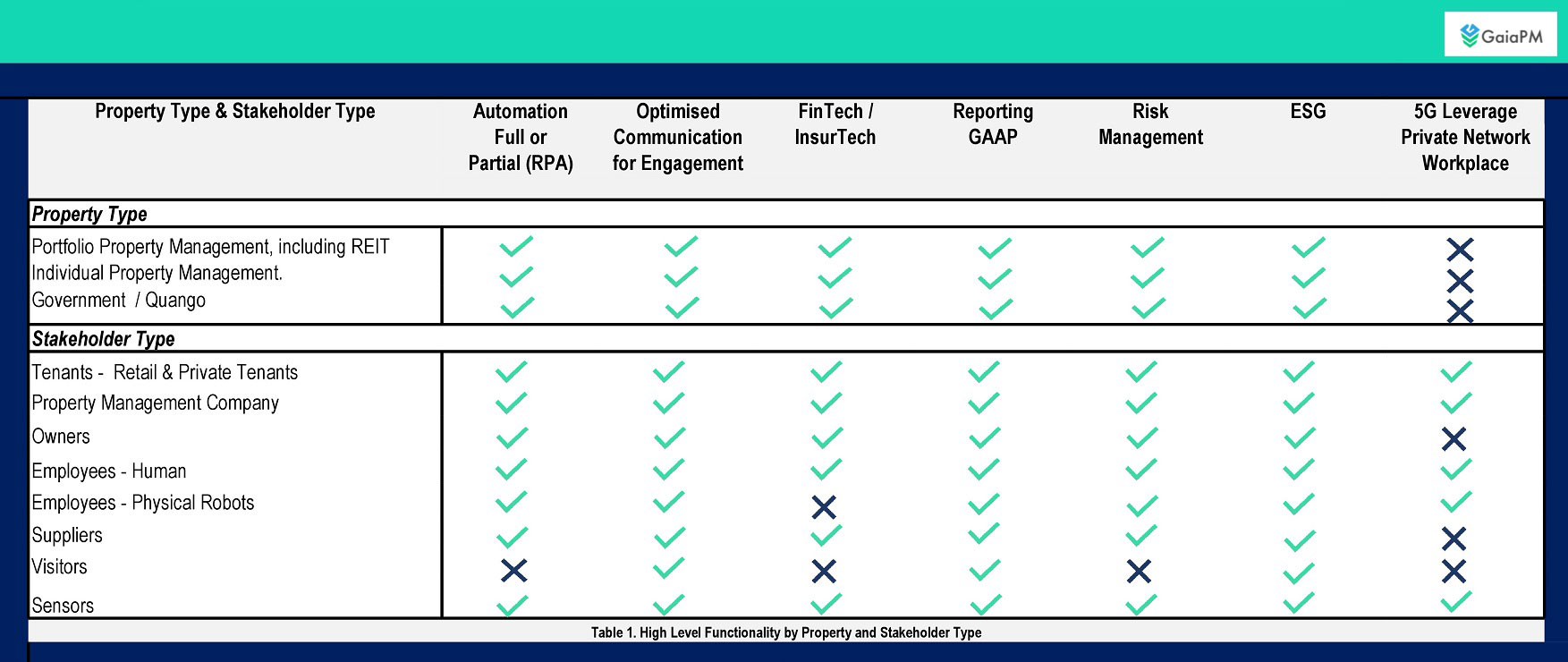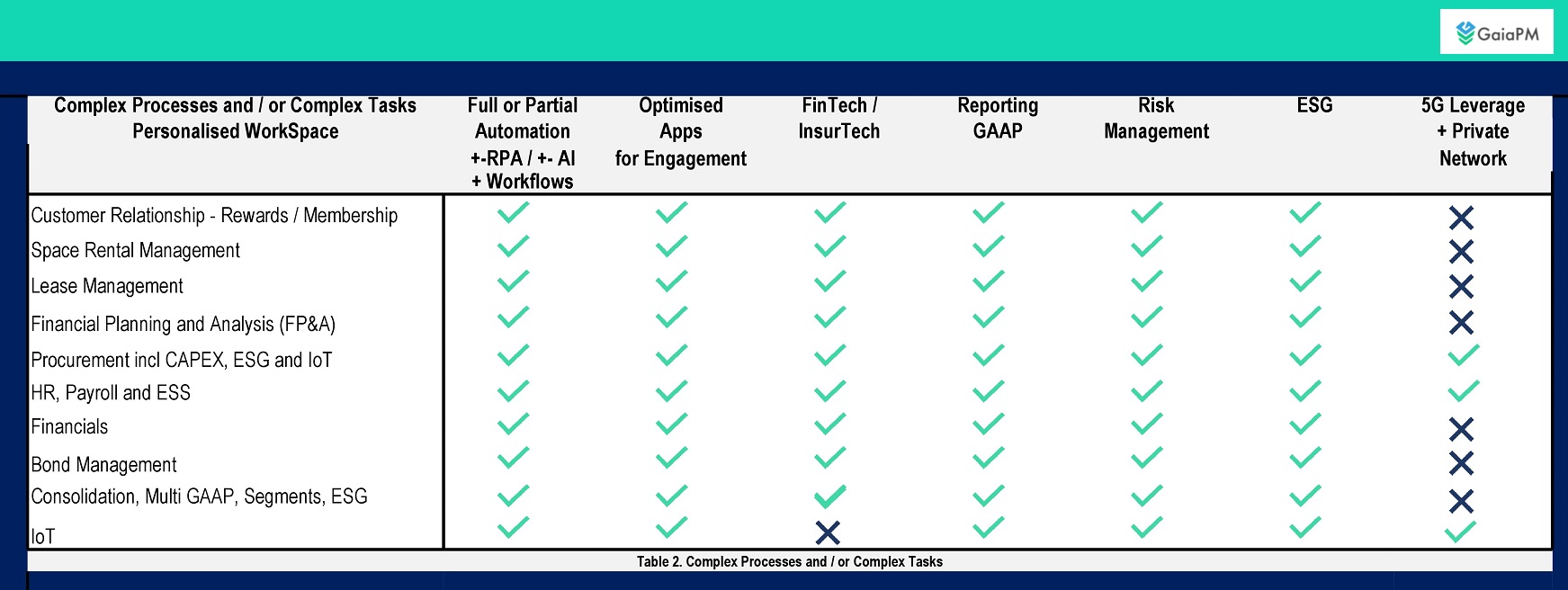With 2022 fast approaching, some business functional areas within property corporations will be striving to achieve the highest numbers possible, whilst others will be aiming for zero.
Latest PropTech will be driving this forwards through the enabling of smarter, more interconnected processes to bring together various internal and external data sets in a much more meaningful way to create value for multiple stakeholders.
Continually pushing the digital envelope forwards will not only help property conglomerates themselves achieve competitive advantage, but will also go some way to fulfil their external stakeholders needs to receive more value to push forwards their own competitiveness.
Thinking about future workplaces, and how technologies can impact it, can quickly get one’s grey matter excitedly spinning in multiple directions. However, it also quickly reveals that projects around digital enablement can be extremely varied when they are applied across different functional domain areas.
Some digital enablement, such as app interactions with elevators and cleaning robots to make them “touchless”, will be more focused on extending physical environments to the digital world. Others will be focused on the building of new or extended digital processes, such as those for operations, HR, and finance for purposes of value creation. Sounds logical, but sometimes in reality actual demarcation lines are more fuzzy, so best to keep an open mind, because there will likely be some areas of overlap where it makes sense.
The common denominator across all of these functional areas is that these digital processes will be smarter, timelier, and interconnected with each other to both improve & enrich data quality. They will additionally provide deeper insights to stakeholders, whilst removing or reducing friction for improved positive experiences. This can be across your international property portfolios, regardless of whether these processes actually relate to personalized space management, talent engagement or specific business workflows in property management system, such as bond or lease management.
Connectivity will result in far fewer disparate data dots, which will have a lot more collaborative interconnections between them. This will catapult productivity forwards to power a new generation of stakeholders, resulting in the next generation of data driven property enterprises.
Digital processes underpin everything to various extents and, looking at this holistically from above, this equates to there being a large number of corporate stakeholders involved in a broad range of both quantitative and qualitative style processes, as illustrated within Table 1: High Level Functionality by Property and Stakeholder Type. This diversity of process makes it much harder for corporations to distill the core common functionality that will be required in their solution sets, thereby making it tougher to navigate through it.
Assessing how to tackle individual digital projects at a more detailed level can also be far more challenging, particularly around the areas of change management, and recognizing that processes will fall quite broadly into what can be described as complex processes across many employees, and complex tasks that touch only a few, as illustrated here in Table 2: Complex Processes and / or Complex Tasks.
Worthy of note within this quite broad categorization, is that some processes will be far more dependent than others on needing to access, bring together, and organize data from across a broad range of existing applications for its ongoing deeper transformation, as well as enrichment. This means that detailed integrations will potentially be required in order to ensure the success rate of individual projects, but also noting that this work surrounding integrations is often underestimated by project teams, as will be drawn out below.
Moving forwards it is often the subtleties of digital enablement that can derail a project, and these can materialize before, during, or after completion. Five examples follow here, but there are more:-
1. Digital ROI. Project justification processes within every organization can be very different and each corporate has its own level of financial maturity and materiality. Typically, digital justifications fall as follows: those having to go through a formal multi stepped authorization process, and those that get ad hoc budget approval, simply because of the stakeholder’s involved (i.e. closed loop). Intellectually on the surface it seems to make a lot of sense, despite it being difficult in some cases for project owners to get to any really meaningful hard supporting numbers.
Additionally corporate sign off procedures for ERP software from an internal corporate perspective are now more complex than ever, eg cybersecurity, ESG etc, so vendors working with customers, and vice versa, during the early stages can help to ring fence where an issue might arise, so that it can be headed off and factored into UAT schedules to avoid or minimize delays etc.
2. Traditional HR structures can exacerbate change human resources management especially when processes cross functional responsibility lines, as does the observation that it is only the CEO who is typically involved across the entire management organization. This coupled with the fact that digital enablement teams are often put together without enough functional representation, means that many of the issues described herein will come to a head during any project.
3. Modern digital systems meeting legacy is a barrier that can get into the way of successful project execution, and the macro challenges being faced here are the same ones that have caused inefficient spreadsheets to be used on a continual basis over the years in the first place.
Simply put, data needs to be transformed so that it can be useful from a practical perspective. Achieving this often requires detailed knowledge across multiple system types, including legacy, so that data can easily flow in the right formats to achieve the required end result. The challenge here is that the knowledge to undertake integration work is not always contained within a single person, nor organization.
4. Data Compliance. Considerations re the physical, logical, legal and taxable location of data are also very relevant and topical here. Whilst there is a primary focus from project teams on designing business flows, the same amount of energy is not always given to incorporating the required levels of cybersecurity, operating controls and privacy compliance, at least at the beginning. Increasingly, corporate focus in this area is becoming ever more important and relevant, as regulations around data handling are changing frequently, and might actually require the use of multiple cloud vendors to reach a workable solution.
Whilst on the subject of compliance, digital enablement brings more detailed visibility to stakeholders as contextual actionable reporting can be @anywhere @anytime within a process. Plus, during the transformation process itself, data can be enriched to provide even more depth. Automated processes reduce errors, noting that it is the process owner who decides on the level of automation i.e. none, partial, full or even just an eyeball review. Changes can be iterative.
Additionally, as another example leasing contracts can be exploded over their term into all relevant accounting entries, together with any amortizations. Contextual actionable reporting can be done at both contract and detailed levels @anywhere @anytime within the property management system throughout this period. This provides additional granular control relating to any delinquent payment, not to mention achieving accurate compliance with IFRS 16 and ASC 842. Leveraging multiple payment options also helps end-users to remain on track within their contractual terms.
5. Cybersecurity and Privacy. These are on the flip side of the same coin and need to be considered end to end throughout any process. There are strengths and weaknesses to automated workflows. On the one hand, less or no manual intervention might be required during processing, and this positively equates to a reduced chance of human error or ad hoc nefarious data interactions.
On the other hand, this lesser human interaction means that there is a broader more automated threat vector surface area open to attack, but simultaneously a reduced risk of threat actor detection by the corporation due to there being a lower number of staff interactions with data.
Sometimes misunderstood, is that a threat actor’s general intent is twofold. First, their task is to gain entry into a corporate system by taking the easiest route possible, and then to move horizontally to your more valuable data assets to steal or encrypt them, i.e. ransomware. Secondly, to hijack processes in order to get you to redirect material cash funds to the threat actor i.e. lease payments, treasury movements, significant asset acquisitions etc.
Whilst either may be part of a highly targeted threat to reach an end goal, attacks typically fall into either i) scattergun attacks ie a numbers game to get any employee to click on a nefarious link (which then triggers a bad program to run that goes on to encrypt your business files for a ransomware demand etc) or ii) a highly targeted attack.
Regardless of which, employees (and especially management) need to understand, and be aware of, how attacks can happen and how to mitigate them as far as possible. As a result, broad based tight controls should be in place as well as managed at all times, and there should also be a repeating proactive mechanism to keep employees and management in the loop to regularly reinforce best practices surrounding privacy and cybersecurity.
Deployment of latest technologies drives competitive advantage in multiple areas by reducing process friction, and providing stakeholders with more timely and better quality information for more proactive decision making. Today’s technologies can cover both complex tasks and complex processes, but it is important to recognize that success will ultimately depend on three things: i) your ability to design and deploy value added ultra-granular transformational processes that fully leverage your other core systems to protect past investments; ii) having the required all round project team representation; and iii) access to relevant systems integration skills.
GaiaPM, a member of the FlexSystem Group, provides lease and property management software designed to help you drive performance up and costs down. As a global solutions provider in over 38 countries GaiaPM, together with proven solutions for financials, human resources, and operations is a business software vendor to 1 in 10 Forbes Global 2000 (May 2020), and 1 in 5 Global Fortune 500 (August 2020), operating at the intersection of new digital process and payment technologies, whether on-premise, hybrid or cloud, to provide you with iterative opportunities for value creation.




